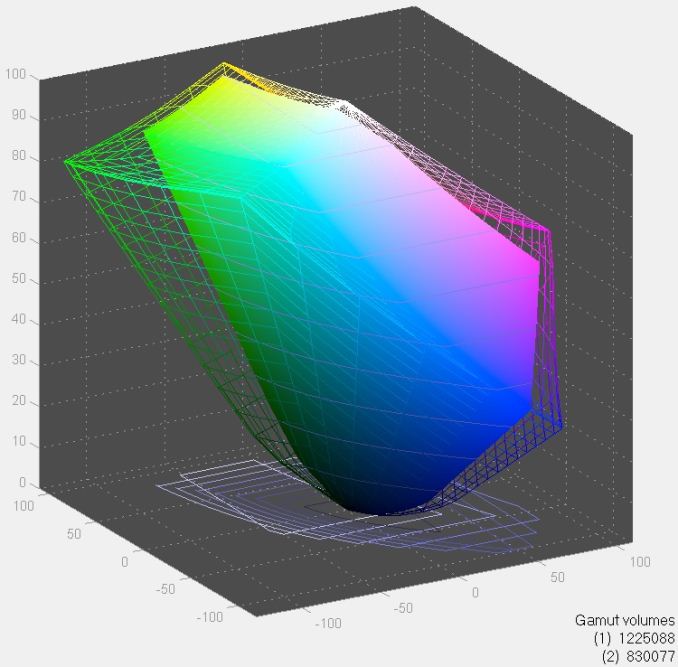
Original Link: https://www.anandtech.com/show/6921/cyberpowerpc-fangbook-gaming-notebook-review
CyberPowerPC FangBook Gaming Notebook Review
by Dustin Sklavos on May 1, 2013 12:01 AM EST_678x452.jpg)
Introducing the CyberPowerPC FangBook
It's been a little while since we've had any blood in from CyberPowerPC and I'm pretty happy to have them back around town. They've been doing perfectly fine, but remember that the past two years have seen a lot of divergence by boutiques as they all begin to carve out more distinct niches. The resurgence of popularity in PC gaming only adds fuel to that divergence, as branding becomes ever more important, and that's what brings us to the customized MSI GT70 we have on hand today in the form of what CyberPowerPC calls their FangBook.
.jpg)
If it looks familiar, we've tested a nigh identical chassis before from iBuyPower, in the form of their Valkyrie. But that was last year, August, and CyberPowerPC has put their own spin on this chassis. So if a lot of this review looks familiar, that's going to be a large part of it, and in fact I'm going to eschew going over the design again in detail. The key distinctions in terms of the shell are CyberPowerPC's lid and interior coloring, but beyond those there isn't a whole lot of different action to check out there.
On the other hand, though, we do get a chance to check out some new hardware, and that's the really interesting part. We keep the great-feeling-but-poorly-laid-out keyboard from the original MSI design, along with the weight and slightly goofy touch controls. Internally, though, we get to check out the last respin of the entry-level Ivy Bridge quad core, the Core i7-3630QM, but perhaps more importantly we get to play with a Kepler-based GeForce GTX 675MX. The iBuyPower Valkyrie enjoyed a GeForce GTX 675M, which was essentially a rebranded GeForce GTX 580M (itself a cut-down desktop GF114). While we've heavily modified our benchmarking suite for 2013, I do have figures for the GTX 580M/GTX 675M to compare against the shinier, newer GTX 675MX.
| CyberPowerPC FangBook Specifications | |
| Processor |
Intel Core i7-3630QM (4x2.4GHz + HTT, Turbo to 3.4GHz, 22nm, 6MB L3, 45W) |
| Chipset | Intel HM77 |
| Memory | 2x8GB Corsair Vengeance DDR3-1600 (Maximum 32GB) |
| Graphics |
NVIDIA GeForce GTX 675MX 4GB GDDR5 (960 CUDA cores, 666MHz/3.6GHz core/memory clocks, 256-bit memory bus) Intel HD 4000 Graphics (16 EUs, up to 1.1GHz) |
| Display |
17.3" LED Matte 16:9 1080p Chi Mei N173HGE-L11 |
| Hard Drive(s) |
Intel 520 Series 60GB SATA 6Gbps SSD Western Digital Scorpio Black 750GB 7200-RPM SATA 3Gbps HDD |
| Optical Drive | TSSTCorp SN-208AB DVD+/-RW |
| Networking |
Killer Networks e2200 PCIe Gigabit Ethernet Intel Centrino 2230 802.11b/g/n Bluetooth 4.0 |
| Audio |
Realtek ALC892 HD audio Four speakers Mic, headphone, line-in, and line-out jacks |
| Battery | 9-cell, 87Wh |
| Front Side | Speaker grills |
| Right Side |
2x USB 2.0 Optical drive |
| Left Side |
Vent 3x USB 3.0 SD card reader Mic, headphone, line-in, and line-out jacks |
| Back Side |
Kensington lock AC adapter Ethernet D-SUB eSATA HDMI Vent |
| Operating System | Windows 8 64-bit |
| Dimensions |
16.9" x 11.3" x 2.2" 429.3mm x 287mm x 55.9mm |
| Weight |
6.9 lbs 3.1kg |
| Extras |
Webcam USB 3.0 Card reader THX TruStudio PRO audio Red backlit keyboard |
| Warranty | 1-year limited and lifetime phone support |
| Pricing | $1,578 |
Fundamentally, the Valkyrie CZ-17 and FangBook are hanging out in the same neighborhood. Both enjoy the same perks (backlit keyboard, healthy port configuration, reasonably low heat and noise), and even the same integrated Killer Networks wired ethernet. We want to look at what's changed in the interim.
First, the bottom rung Intel Core i7-3610QM has seen a mild refresh in the form of the i7-3630QM; the 3630QM is essentially identical, but with a 100MHz bump on the nominal and turbo clocks to 2.4GHz standard and 3.4GHz turbo on one or two cores. Our review unit also gets 16GB of Corsair Vengeance DDR3-1600 along with a 60GB Intel 520 series SSD; that SSD is no longer available on the CyberPowerPC, having unfortunately been replaced by a 64GB SanDisk SSD based on a slower Marvell controller.
Where I would like to take CyberPowerPC to task is in the wireless hardware that comes standard with the FangBook. I posted my feelings about 2.4GHz wireless to my personal Twitter in terms not particularly safe for public consumption, but essentially my issue is this: the Centrino 2230 with integrated Bluetooth is still a bottom rung, 2.4GHz-only solution. I might not have cared as much before I had a dual band router in my apartment, but now that 5GHz wireless is becoming more common, I really have to bring the hammer down here. 5GHz is a generally less crowded band, and also this is 2013, so maybe our wireless technology should advance further than it was when I started writing for AnandTech. In 2010.
Finally, we get to what I think is the meat of the review. Late last year, NVIDIA refreshed their 600 series with the GeForce GTX 670MX and 675MX, replacing the Fermi-based 670M and 675M. For reference, the 675M is a rebranded 580M, certainly a formidable GPU in its own right, boasting 384 CUDA cores (essentially a full GF114) with 620MHz on the core clock, 1240MHz on the shaders, and 3GHz on the GDDR5. The 675MX, on the other hand, is basically a full GK106 (desktop GeForce GTX 660), though like the FangBook, some of them use harvested GK104s. It sports 960 CUDA cores but drops the hot clocked shaders, so we're looking at 666MHz across the cores and 3.6GHz on the GDDR5. Both chips feature a 256-bit memory bus.
Doing the math (or just being lazy and opening GPU-Z) reveals that the 675MX has 120% of the 675M's memory bandwidth, 135% of the 675M's texture fillrate, and ~135% of the 675M's pixel fillrate. That means that at absolute worst, the 675MX should be about 20% faster than the 675M. All of this on top of the newer, more efficient Kepler architecture, and the 675MX should theoretically be a slam dunk when compared to its predecessor.
As it turns out, though, that's not entirely the case.
System Performance
Unfortunately due to our refresh, this section is a little truncated, but I'm hoping it will at least be somewhat enlightening. My primary interest here is in the comparison between the NVIDIA GeForce GTX 675M and the GTX 675MX, and secondary is the mild evolution from the Intel Core i7-3610QM to the i7-3630QM. Until we get some more gaming notebooks in (and we do have more on the way), you're going to see this gaming behemoth tussling with notebooks well below its weight class.
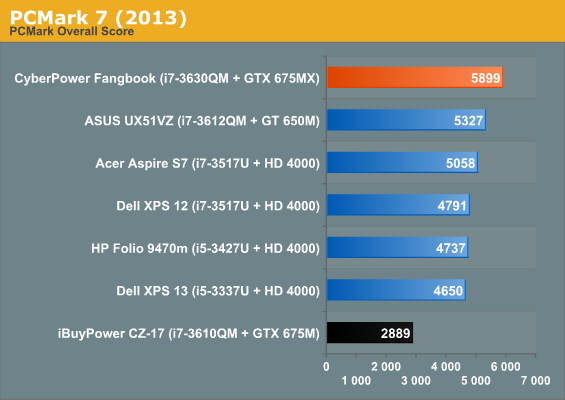
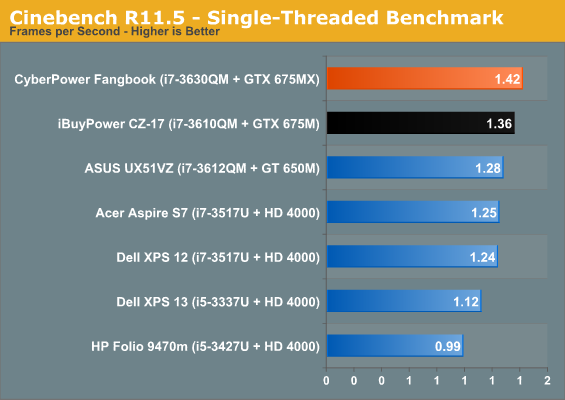
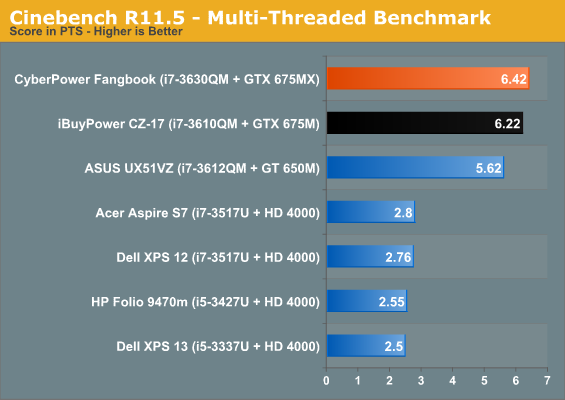
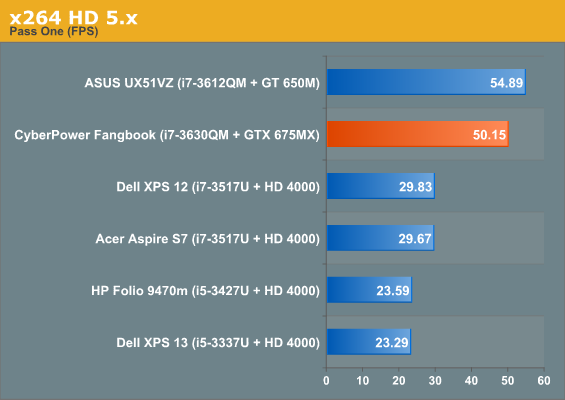
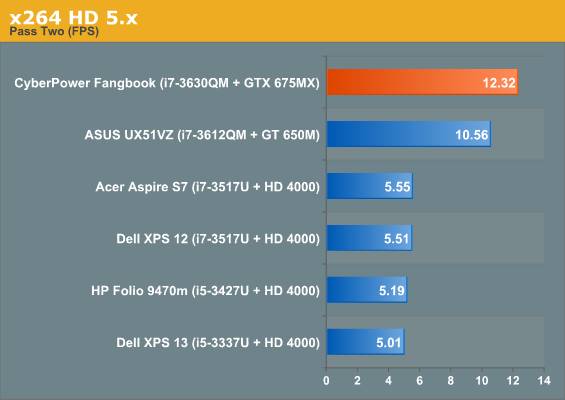
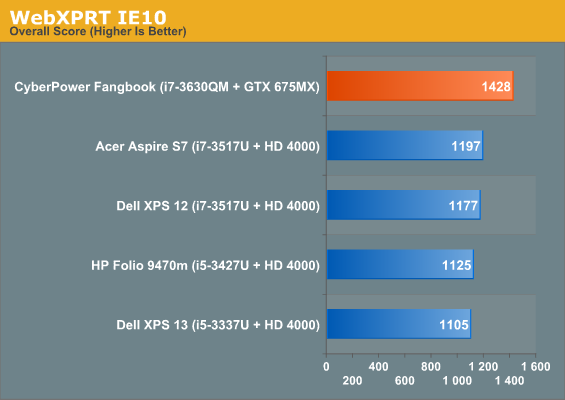
Our CPU-based benchmarks are unsurprising since the i7-3630QM in the FangBook is fighting it out with dual core processors running at a third of the voltage. The 3630QM's improvement on the 3610QM is as incremental as you'd expect; note that in PCMark 7, the Valkyrie falls well behind. That's due to the Valkyrie not shipping with an SSD standard at the time, which hamstrings performance in PCMark.
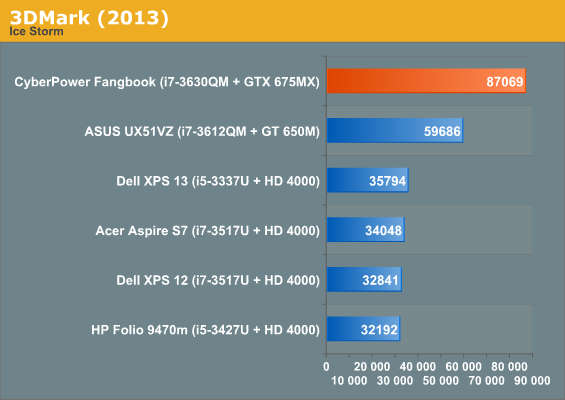
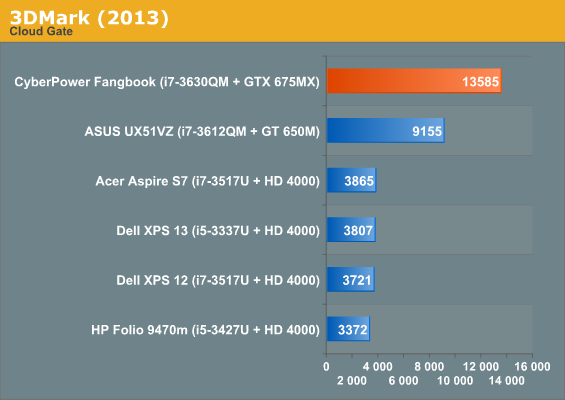
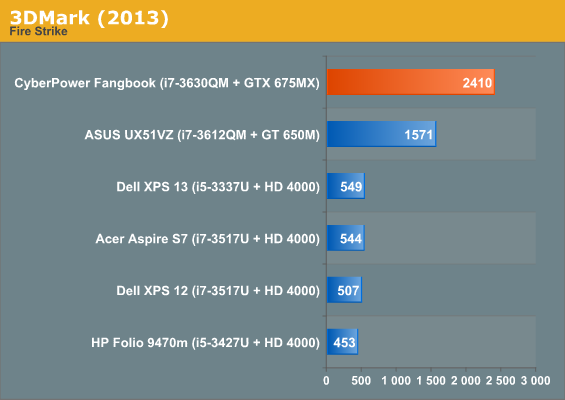
Remember that Intel optimizes for 3DMark, so their best case scenario is being a third as fast as a 100W dedicated GPU. In practice it's obviously a much bigger difference.
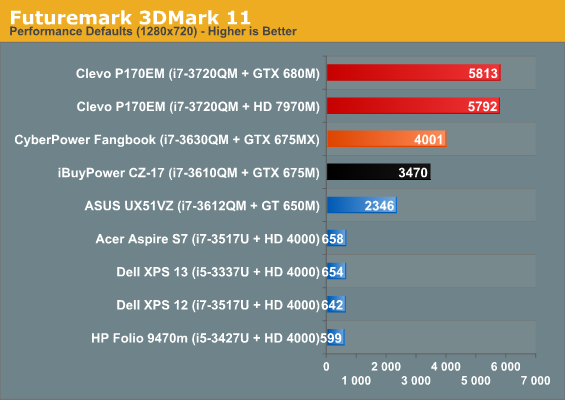
Until we have more results from gaming notebooks in our new testbed, we're kind of stuck with 3DMark 11 to tell us the story, and it's an interesting but unsurprising one. First, the GTX 675MX is about 115% as fast as the GTX 675M, which is a decent jump and roughly around what we should expect. What's more interesting is the absolutely staggering gulf between the 675MX and the 680M and AMD Radeon HD 7970M. This isn't surprising; the 680M is a GK104 with just one shader cluster disabled, so it should be running roughshod on the 675MX. This speaks to a need for NVIDIA to have something to bridge that gap, though. The 675MX isn't even hanging out in the 680M's neighborhood, but unfortunately it's the fastest chip CyberPowerPC will sell you in the FangBook. Interestingly, iBuyPower can't beat it, but AVADirect will sell you an identically configured notebook with the same chassis and a 680M for another $400. That kind of pricing won't set the world on fire, but if you want the best mobile gaming experience you can get before going multi-GPU, the 680M is probably worth the money.
We know how the 675M and 675MX compare to each other in synthetics, but how do they stand in practice? As it turns out, the gulf between them isn't particularly wide. Note that the stand-in for the 675M is my own Alienware M17x R3 with an i7-2720QM and GTX 580M. Since the 580M and 675M are nigh identical, this is a valid comparison, though my CPU is a generation behind and slightly slower than the FangBook's. All of these results use NVIDIA's beta 320.00 drivers.
|
1366x768 Medium Settings |
675M | 675MX | % Gain |
| Bioshock Infinite | 96.5 | 107.3 | 11.2% |
| Skyrim | 87.1 | 99.5 | 14.2% |
| Sleeping Dogs | 93.3 | 106.4 | 14% |
| StarCraft II: HotS | 59.5 | 66.3 | 11.4% |
| Tomb Raider | 136.2 | 137.6 | 1% |
At these settings all of the games are very playable, so there's no real news to report here. It's interesting to note that Tomb Raider appears to be CPU limited here, though.
|
1600x900 High Settings |
675M | 675MX | % Gain |
| Bioshock Infinite | 57 | 62.4 | 9.5% |
| Skyrim | 69.3 | 75.5 | 8.9% |
| Sleeping Dogs | 64.5 | 76.7 | 18.9% |
| StarCraft II: HotS | 54.2 | 59.8 | 10.3% |
| Tomb Raider | 72.6 | 77 | 6.1% |
Put a little more stress on the GPUs, and they...reduce the gap? At 1600x900, performance gains drop for three of the games. Only Sleeping Dogs and Tomb Raider see improvements.
|
1920x1080 Ultra Settings |
675M | 675MX | % Gain |
| Bioshock Infinite | 28 | 35.6 | 27.1% |
| Skyrim | 53.9 | 58.2 | 8% |
| Sleeping Dogs | 33 | 36.8 | 11.5% |
| StarCraft II: HotS | 44 | 51.1 | 16.1% |
| Tomb Raider | 21.3 | 22.1 | 3.7% |
Improvements really depend on the game you're playing, but the GTX 675MX isn't the vastly superior chip we were expecting. While it's consistently faster than the GTX 675M (as it should be), it's not fast enough to merit seeking out if you already have a 580M/675M. I was honestly expecting and hoping for a more robust improvement, but the difference is fairly incremental.
Given that these are extremely high end GPUs, aftermarket ones aren't as difficult to find. I had a 680M running in my M17x R3 for a little while, and it definitely can be done and done stably (though you do sacrifice Optimus). If you're operating on last generation's top end, like the 580M or the HD 6990M, a jump to an HD 7970M or 680M will absolutely produce a substantial gaming improvement. It's the more incremental upgrades like the 675MX that are less attractive.
Battery Life
Given that we're using a newer, much more vigorous battery testing methodology now, it's harder to make an accurate comparison between the CyberPowerPC FangBook and competing gaming notebooks. Unfortunately all we have for the moment are ultrabooks, all of which are running substantially slower (and less power hungry hardware). [Ed: I added the ASUS UX51VZ to the list as well; still an Ultrabook, but substantially faster than the ULV models.] Perspective remains important, though, and battery life is one of the major sacrifices made when you use a heavy gaming notebook. It's not as bad as it used to be thanks to switchable graphics technology, but we're still running a 45W CPU.
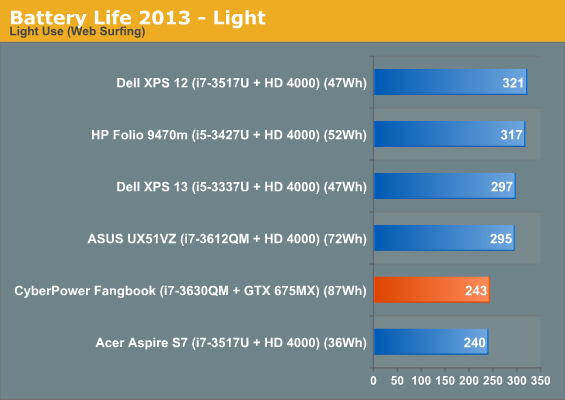
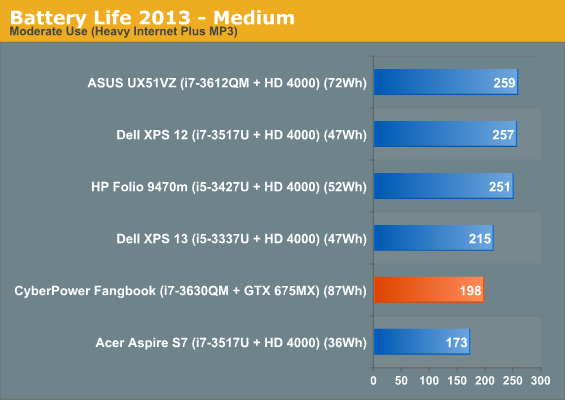
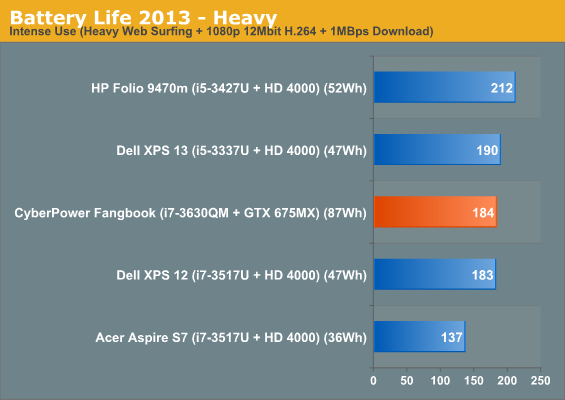
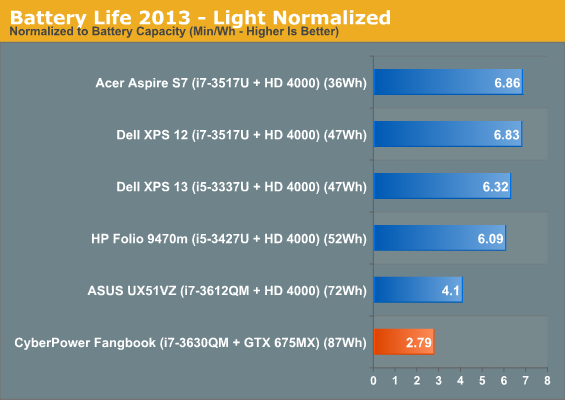
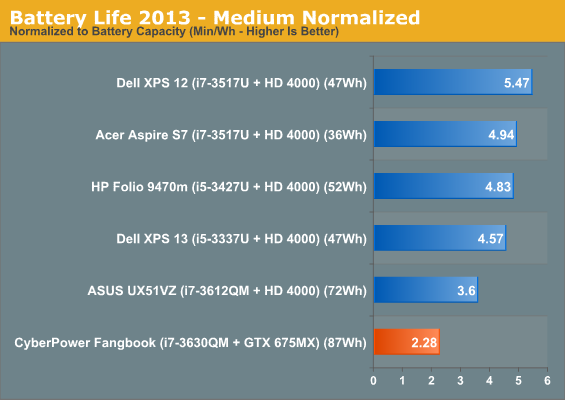
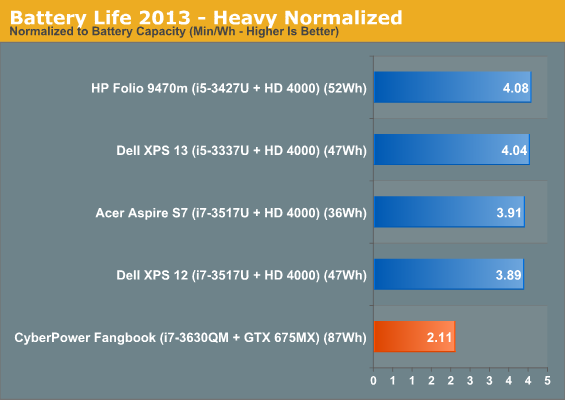
Given that we're dealing with a 45W CPU competing with 17W CPUs while running a bigger display, the FangBook's efficiency really isn't half bad. We still get a minimum of three hours of useful running time, which is appreciated.
Display Quality
Amusingly enough, we're starting to get to the point where a 1080p display on a 17.3" notebook may not cut it. For now, though, it's a good size, especially for a gaming notebook that isn't going to be able to push games beyond 1080p. The FangBook is using the exact same panel as iBuyPower's Valkyrie CZ-17 (again, same chassis), so it remains to be seen if there's any real difference. We also want to see how it stacks up against competing options in the gaming market. Note that the FangBook is also using a matte panel while the Alienware M17x R4's and Dell XPS 13's (filling in here for IPS 1080p) are glossy.
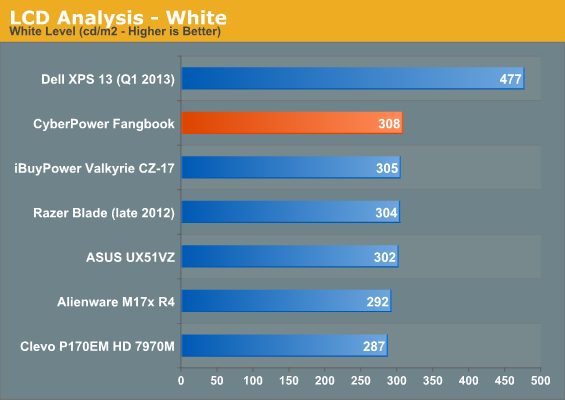
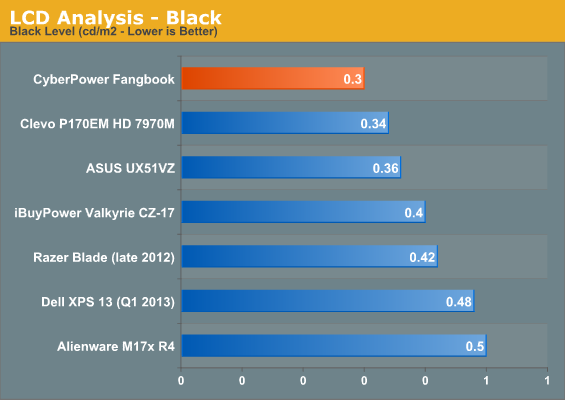
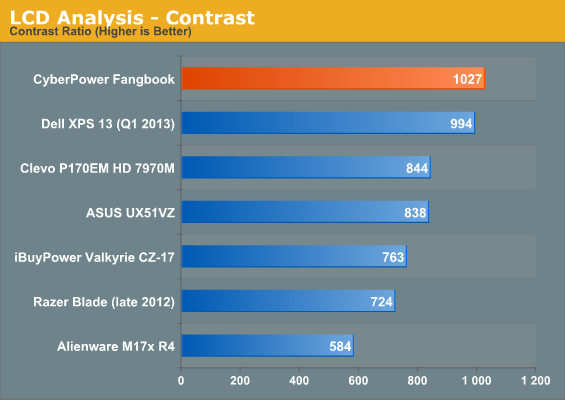
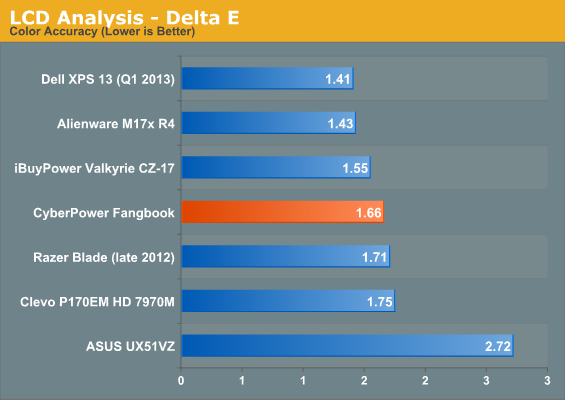
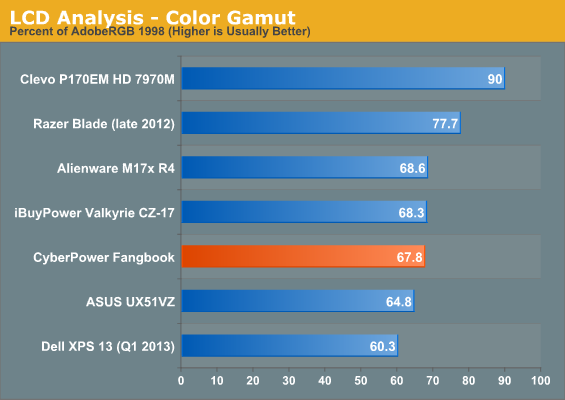
Interestingly, despite using the exact same panel and chassis, the FangBook posts slightly better performance all around. All of these 1080p displays are competitive, and for being TN panels they hold their own with Dell's XPS 13 and its IPS panel.
Two Conclusions
When evaluating the CyberPowerPC FangBook, we're really evaluating two completely separate things. The first is the performance of the NVIDIA GeForce GTX 675MX, which has completely supplanted the GTX 675M in this chassis and largely supplanted it in the marketplace. The second is how good of a deal the FangBook is compared to competing boutiques. Any evaluation about the quality of the notebook's build would essentially echo my review of iBuyPower's own Valkyrie CZ-17, though it does bear mentioning that the FangBook was a bit of an eyecatcher when I had friends over the other day, and I think CyberPowerPC's panelled lid design has a nice pop to it.
The improvement Kepler brings to the 675M in the form of the 675MX almost feels too incremental, but NVIDIA also painted themselves into a corner by rolling the 580M into the 675M in the first place. The 675MX is definitely faster than the 580M/675M, in the neighborhood of about 10-15%, and it will afford you a modest bump in settings or slightly smoother gameplay depending on what you prioritize. It should also use less power under load, which is certainly a benefit. Where I think NVIDIA runs into trouble is that they have a frankly massive performance gulf between the 675MX and the 680M. AMD addresses this gap with a Radeon HD 7950M, and while drivers remain an issue on their side of the fence, they've also been steadily improving. The flipside is that AMD's Radeon HD 7900M series is also relatively scarce, with the high end essentially dominated by NVIDIA right now.
As far as the 675MX goes, consider this. While ultrabooks got a big boost from Ivy Bridge, gaming notebooks received a far more modest one, and much as Sandy Bridge users shouldn't have felt any rush to upgrade to Ivy Bridge, users with a HD 6990M or 580M/675M shouldn't be trying to track down a 675MX (much less a 670MX) on an MXM card.
.jpg)
The other part of the FangBook equation is its value for your gaming dollar. Our review unit runs $1,578, which is pricey but not unheard or unreasonable for a beefy gaming notebook. It gets you an i7-3630QM, a 60GB SSD system drive, and a 750GB storage hard drive, all alongside 16GB of DDR3-1600 and the GeForce GTX 675MX. For this configuration, AVADirect charges you $1,635, and you actually downgrade to a GTX 675M. iBuyPower will charge you $1,564, which is basically a wash. Other boutiques with this chassis are basically a wash, so if nothing else, CyberPowerPC is pretty competitive on price. Clevo notebooks tend to be a little pricier, and though I still think the M17x R4 is the most ideal gaming notebook available, it will punch you in the wallet until every last ounce of change comes out. So if you want to hang out in the FangBook's performance neighborhood, you're looking at roughly a $500 premium to go Alienware.
With all that said, this isn't how I'd personally configure the FangBook, and you can get a better deal if you work the angles a bit. For about $60 less, I'd go for a single 250GB Samsung 840 SSD (remember there are two drive bays so you can always upgrade later), cut the RAM down to the stock 8GB of DDR3-1600, and upgrade the wireless to a dual-band card. I'm almost completely sold on SSDs and 5GHz Wi-Fi at this point and consider them both to be worth the sacrifices.
Bottom line, this MSI chassis is still an excellent one for gaming. iBuyPower and CyberPowerPC are basically competitive with each other and the least expensive options on the market, so it's going to be a matter of styling and customization options that will sway you one way or the other. Now if they could just customize the keyboard, we'd have something truly noteworthy to discuss.

_thumb.jpg)
_thumb.jpg)
_thumb.jpg)
_thumb.jpg)
_thumb.jpg)
_thumb.jpg)
